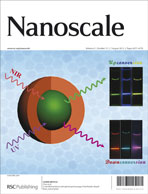C74 endohedral metallofullerenes violating the isolated pentagon rule: a density functional theory study†
Abstract
Precise studies on M2@C74 (M = Sc, La) series by means of DFT methods have disclosed that certain non-IPR isomers are more stable than the IPR structure. M2@C2(13295)-C74 and M2@C2(13333)-C74, both of which have two pentagon adjacencies (PA), present excellent thermodynamic stability with very small energy differences. Statistical mechanics calculations on the M2@C74 series reveal that M2@C2(13295)-C74 and M2@C2(13333)-C74 are quite favoured by entropy effects below 3000 K. Sc2@C74 and La2@C74 series are found to have similar electronic transfer but different electronic structures due to the distinct properties of scandium and lanthanum elements according to Natural Bond Orbital (NBO) analysis in conjunction with orbital interaction diagrams. Investigations of bonding energies reflect quite different influences of the two types of metal atoms to C74 metallo-


 Please wait while we load your content...
Please wait while we load your content...